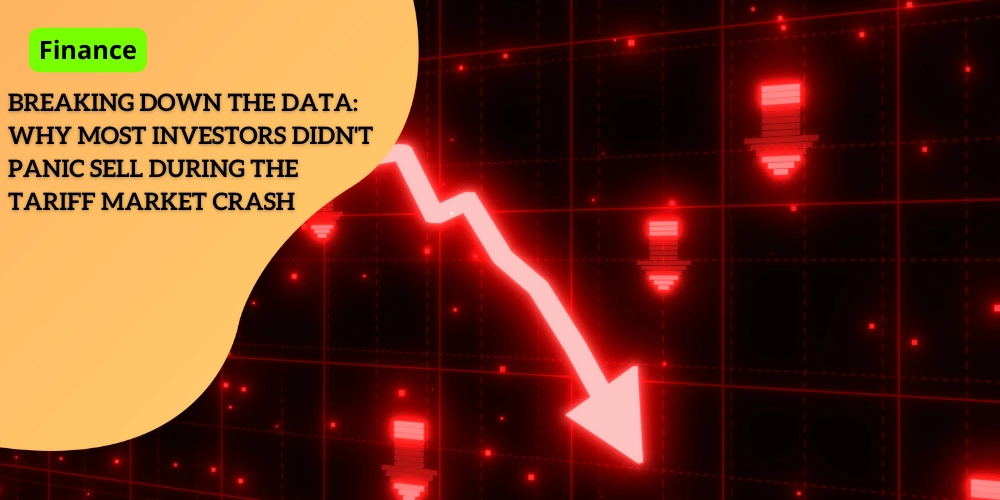Breaking Down the Data: Why Most Investors Didn’t Panic Sell During the Tariff Market Crash

Anúncios
The Market Turbulence: Setting the Scene
Overview of the Early April Stock Market Volatility
Early April was a wild ride for the stock market, and all signs pointed to significant turbulence caused by tariff announcements.
The initial announcement on April 2, which levied tariffs on various imports, sent shockwaves through the financial world.
Anúncios
This move raised fears of escalating trade conflicts, especially involving major economies like the US and China.
Breakdown of the Dramatic Market Swings and Their Causes
The dramatic swings in the market didn’t take long to unfold.
Anúncios
The day after the tariff announcement, April 3, saw the Dow Jones Industrial Average plunging significantly.
The S&P 500 and Nasdaq also had their worst trading day since 2020.
By April 4, China had announced retaliatory tariffs, further exacerbating market instability.
This tit-for-tat led to additional significant drops, with the Nasdaq spiraling into a bear market.
President Trump’s subsequent doubling down on tariffs on April 7 added more fuel to the fire, leading to a market nosedive.
However, markets experienced a brief respite on April 9, when there were indications of a possible reevaluation of the tariff strategy.
This brief moment of relief saw traders exhaling as major stock indices marked gains.
The following series of events had left investors on edge, unsure of what twists and turns would come next.
Initial Concerns About Potential Panic Selling Among Investors
With such a volatile environment, initial concerns among market analysts were rife that this would prompt widespread panic selling among investors.
Traditionally, sudden and significant drops in the stock market can trigger fear, leading to a surge in sell orders as investors try to limit their losses.
The fundamental fear was that this reaction could create a snowball effect, worsening the market downturn.
Yet, emerging data suggested a different narrative.
Instead of succumbing to panic, many investors appeared to stand their ground, holding onto their investments calmly.
This behavior invites a closer examination of investor actions during this tumultuous period, revealing some unexpected insights into investor resilience and strategy.
The chapter that follows will delve into an analysis of investor behavior during this period, exploring surprising data that suggests a more composed approach than initially expected.
Investor Behavior Analysis: The Surprising Data
When the stock market faces turbulence, many anticipate that investors will react with fear and panic.
However, the data from the early April market volatility, triggered by tariff announcements, tells a different story.
Analyzing the actions of Vanguard’s self-directed investors during this period reveals some surprising trends.
Limited Trading Activity
Despite the dramatic market swings, only 8.4% of Vanguard’s self-directed investors executed trades in response to the volatility.
This low trading volume indicates a remarkable level of restraint among investors.
They chose not to react impulsively, suggesting confidence in their long-term investment strategies.
Buyers Overpower Sellers
Interestingly, among the small fraction of investors who did trade, buyers significantly outnumbered sellers by nearly 5 to 1.
This indicates that the majority of those making moves were not panicking and selling off their assets but were instead looking to capitalize on the market dip.
These investors viewed the volatility as an opportunity to purchase stocks at reduced prices rather than a signal to retreat.
Singular Trading Day Activity
Moreover, the analysis showed that most active traders made moves on just one of the five trading days during this volatile week.
This suggests that even those who decided to respond to the market conditions did so in a calculated, measured manner instead of engaging in continuous or frantic trading.
Implications of Investor Behavior
The behavior of these investors aligns with core investment principles: maintaining composure and sticking to the plan despite market turmoil.
By opting to buy during the dip and showing restraint in their trading activity, these investors demonstrated a proactive, strategic approach.
Next, we’ll explore the specific buying patterns that emerged during this turbulent period, further shedding light on the strategic mindset of investors.

Strategic Buying Patterns
Despite the market’s ups and downs in early April, savvy investors recognized an opportunity to purchase stocks at lower prices.
They were not just reacting to the chaos; they were making calculated, strategic choices.
Popular Stock Purchases
During this period, investments in high-profile tech stocks were prevalent.
Nvidia, Amazon, Apple, and Tesla saw significant purchasing activity.
This trend demonstrated confidence in companies with solid growth potential and robust market positions.
Tech stocks, known for their resilience and innovative capabilities, attracted investors looking for long-term growth.
Preference for ETFs
To manage risk more effectively, many investors turned to exchange-traded funds (ETFs).
ETFs offer a diversified portfolio that can mitigate the risk associated with individual stocks.
By opting for ETFs, investors showed a preference for safer investments that still allow participation in market recovery.
This approach highlights a strategic effort to balance potential rewards with minimized risk.
Proactive Trading Behavior
Analysis from investment firms indicated that most traders were proactive rather than reactive.
Contrary to panic selling, these investors sought out valuable buying opportunities amidst the volatility.
Their actions were driven by strategic planning rather than fear, signaling a composed and calculated approach to market fluctuations.
The investors who stayed the course, focused on buying opportunities, and chose diversified options like ETFs exhibited a thoughtful and strategic approach to investing.
By maintaining their cool and following long-term investment principles, they capitalized on market volatility without succumbing to panic.
This strategic behavior aligns closely with the expert principles for investing during volatile times.
Investors who managed to leverage market dips to their advantage are leading the way in smart investing tactics.
Expert Investment Principles During Market Volatility
The Pitfalls of Attempting to Time the Market
It might seem logical to ride out market dips by selling at the first sign of trouble and buying back in when the dust settles.
However, this strategy often backfires.
Markets are notoriously unpredictable, and you might miss out on the best recovery days.
For example, in early April when the market experienced sharp losses due to tariff announcements, it was followed by significant gains just a few days later.
Experts recommend staying invested rather than attempting to time when to enter or exit the market.
“So often, some of the absolute worst days in the market are in close proximity to some of the absolute best days,” explained Akullian of BlackRock.
This principle highlights the risks of missing market rebounds, which can crucially impact long-term returns.
Importance of Maintaining a Long-Term Investment Strategy
Sticking to a long-term strategy during market turmoil can be challenging, but it’s usually the best approach.
Markets will always rise and fall, but history shows that staying the course tends to yield better results.
Since 1966, the average bear market lasted about 15 months, while the average bull market lasts nearly six years .
This perspective helps to counteract the emotional impulse to make hasty decisions during downturns.
A disciplined approach involves developing investment goals, maintaining a diversified portfolio, and controlling costs.
Vanguard emphasizes that investors can’t control the markets, but they can manage their own decisions by avoiding panic.
Understanding That Bear Markets Typically Last Shorter Than Bull Markets
Bear markets can feel daunting, but they are often shorter than bull markets.
The statistics show that while the average bear market persists for about 15 months, bull markets can last almost six years .
This historical context encourages investors to withstand temporary market declines for the potential of longer-term gains.
Understanding these cycles helps investors avoid the emotional trap of selling at low points and missing out on recoveries.
The key takeaway is that patience and perspective can guide more rational long-term investment decisions.
Recognizing the typical behavior of market cycles can be a comforting factor, promoting a steady approach rather than reactive trading.
A strategic, long-term mindset will often weather market turbulence more effectively, positioning investors for success when the market rebounds.
These insights into maintaining a long-term strategy, understanding market cycles, and resisting the urge to time the market build a foundation for smarter investment decisions during volatile times.
Smart Investment Strategies for Turbulent Times
Taking Advantage of Market Dips to Buy Stocks at Discounted Prices
Volatile markets can unsettle even seasoned investors, but they also present opportunities.
When stocks dip due to market conditions, it can be a golden chance to buy high-quality stocks at lower prices.
Early April’s market fluctuation, caused by tariff announcements, saw investors making savvy moves by purchasing stocks like Nvidia, Amazon, Apple, and Tesla during the lows.
It’s a principle as old as investing itself: buying low and selling high.
But intuition alone isn’t enough; it requires discipline and strategic insight.
Consideration of Broad Index Funds for Reduced Risk
For those wary of individual stock volatility, broad index funds offer a safer alternative.
These funds mitigate risk through diversification, spreading investments across multiple sectors and companies.
Consequently, they are less susceptible to the sharp swings that characterize individual stocks.
During early April’s turbulence, many investors gravitated towards Exchange-Traded Funds (ETFs), appreciating them as a “volatility-driven alternative” to individual investments.
This approach aligns well with long-term investment goals, reducing risk while still participating in market gains.
Exploring Minimum-Volatility Investment Options for Stability
Investors looking for even more stability can explore minimum-volatility investment options.
These include specific mutual funds and ETFs designed to minimize volatility through careful asset selection.
The idea is to offer a more predictable return pattern, which can be particularly attractive during uncertain times.
Minimum-volatility investments balance the desire for growth with the need for stability, making them compelling for cautious investors during market upheavals.
Preparing for market turbulence involves more than just these strategies.
It’s about reinforcing the core investment principles and always being ready to seize opportunities as they arise.






